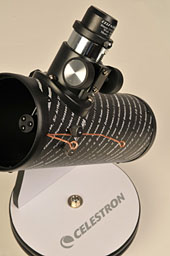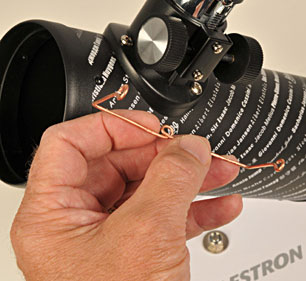In the October 2009 issue, S&T senior editor Dennis di Cicco reviewed the amazing new $50 Celestron FirstScope. It performs far better than any telescope in its price range ever did before, and also better than many scopes that cost twice as much. But not surprisingly considering the price, it does have some shortcomings.
Let's start with the FirstScope's strengths. This telescope has an extremely smooth and steady mount, and the focuser is also quite good. Those may not sound like such big deals, but the mount and focuser are the two items that render most low-cost telescopes extremely hard to use. You can't view anything at all if your scope wobbles every time you touch it, or you're unable to focus on your target! The FirstScope, by contrast, handles and focuses like a Dobsonian reflector costing several hundred dollars.
Optically, the FirstScope is no great shakes — nor would one expect it to be for $50. But it delivers very pleasing views of the Moon, shows the rings of Saturn, and works fine for low-magnification, wide-field browsing.

Dennis di Cicco
Without a doubt, the two biggest weaknesses of the FirstScope are the lack of any kind of finder and the relatively narrow field of view of its low-power eyepiece. With many telescopes, it's fairly easy to locate your targets simply by sighting along the tube. But the FirstScope's exceptionally short tube coupled with the fact that the scope is normally very low (on a table) makes this method challenging — especially if your target is high in the sky. And because the field of view is relatively small for such a modest-sized telescope, you need pretty good accuracy to locate targets that are small and/or faint.
Many vendors sell red-dot and red-circle finders that can be attached to the FirstScope. Once these are properly aligned, they make finding objects a snap. But typical retail prices for these range from $30 on up, and you may find it hard to justify spending $30 to improve a $50 telescope.

Dennis di Cicco
Fortunately, with a little bit of ingenuity, it's possible to improvise a mechanical peep finder. I've had pretty good luck simply taping a drinking straw to the tube of one of my telescope. Dennis has made a fancier finder (shown at right) out of copper wire. The copper-wire finder attaches to the tube using the standard finderscope bolt, as shown above. Both the drinking straw and the copper-wire finder cost essentially nothing.
The small field of view is also easy to fix — but at a cost. For instance, a 25-mm Plossl eyepiece works beautifully on this scope, yielding a field of view that's twice the diameter (four times the area) of the 20-mm Huygenian eyepiece that's supplied with the telescope. However, most Plossls cost $50 or more -- which is equal to the entire cost of the FirstScope package!
Experienced stargazers almost certainly already own a low-power eyepiece that will work well in this scope. And eyepieces in the 25-mm range tend to be quite inexpensive on the used market.
 0
0
Comments
You must be logged in to post a comment.